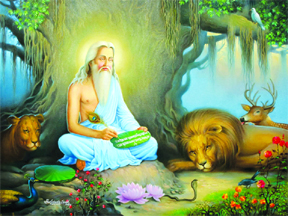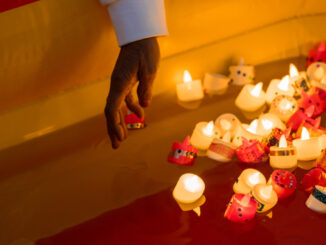
Valmiki Jayanti is celebrated as the birth anniversary of Maharshi Valmiki, writers of one of the most important and popular epics of all time Ramayana. Revered as Adi Kavi or the first poet of Sanskrit language, he underwent a huge transformation, after meeting sage Narada Muni and chanting of the word ‘Mara’ (die) which on repeating several times became ‘Rama’, a word with great spiritual significance and name of one of the avatars of Lord Vishnu. The birth anniversary of Maharshi Valmiki is celebrated every year on Ashwin Purnima as per Hindu lunar calendar. This year Valmiki Jayanti is being celebrated on 17th October 2024
Valmiki was born as Ratnakar and was a dacoit who used to rob people and kill them. His encounter with Narada Muni transformed his life as he advised him to chant the word Rama. However, Ratnakar could not get himself to chant the word even after several attempts, so Narada asked him to say ‘Mara’ instead, which is Rama spelled backwards in Hindi. The Mara turned Rama eventually and as his penance continued for several years as anthills formed around him. Lord Brahma happy with Ratnakar’s penance blessed him and named him Valmiki.
Along with penance spanning several years, he acquired learning of scriptures from Narada and went on to be rechristened as Maharshi Valmiki. As his new life started, Valmiki touched by the sorrow of a female bird upon the death of her partner uttered his first shloka and that’s how his writing journey began. However, it was only after Lord Brahma tasked him with writing Ramayana that the real purpose of his life began.
As per Ramayana, Lord Rama met Valmiki during Vanvasa or his period of exile and later he gave shelter to Sita Mata in his hermitage when Rama banished her. Kusha and Lava, the twin sons of Lord Rama were born in his hermitage where he taught Ramayana to both of them.
According to legend, Maharishi Valmiki met Lord Rama during his exile. After Lord Rama asked Sita to leave the kingdom of Ayodhya, he rescued her and provided her with shelter. She gave birth to the twins, Luv and Kush, in his ashram. The great sage became their teacher when they were young, teaching them the Ramayana, which contains 24,000 verses (shlokas) and seven cantos (kandas).
Another popular belief is that in his early years, Valmiki was a highway dacoit named Ratnakar. He was born to a sage named Prachetasa on the banks of the Ganges in ancient India. Ratnakara was his birth name. As a child, he got lost in the jungles and was found by a hunter, who raised him as his own son. He grew up to be a hunter like his foster father, but he also supplemented his livelihood by being a bandit. He eventually met Maharishi Narada and attempted to rob him. He used to rob and murder people until he met Narad Muni, who converted him into a devout follower of Lord Rama.
After years of meditation, a divine voice declared his penance successful and bestowed the name Valmiki, the one who was born out of ant-hills. For being the first poet of Sanskrit literature, he was later known as Adi Kavi. Since then, Hindu devotees continue to recite his works, particularly the great epic – Ramayana. The birth date and birth time of Maharishi Valmiki are unknown, but as per the beliefs, he lived around 500 BC.
Rituals
People pay their respects to this renowned saint and poet Valmiki Jayanti. Several processions carrying Valmiki’s portrait are held in various towns and villages. On this day, Hindu devotees worship him fervently. Prayers are offered to his portrait in many places.
On this day, recitations of the Ramayana are held in Lord Ram temples across India. In India, there are a number of temples dedicated to Maharishi Valmiki. These temples are lavishly decorated with flowers on the occasion of Valmiki Jayanti. Several incense sticks are lit, creating a pure and blissful atmosphere. In these temples, kirtans and bhajan programmes are held. On this day, many devotees visit Lord Rama temples and recite a few verses from the Ramayana in remembrance of Maharishi Valmiki. On Valmiki Jayanti, free food is distributed to the poor and needy. On this day, doing charity is thought to be extremely rewarding. Hanuman Puja is also performed in many parts of the region. You too can perform Hanuman Puja along with the recitation of Sunderkand at the comforts of your home.
Valmiki Jayanti Celebrations Across India
In the northern parts of India, especially among Hindu devotees, Valmiki Jayanti is celebrated with great zeal. On this day, people participate in large processions known as Shobha Yatras, in which they parade representations of a priest dressed in saffron robes, holding a plume and paper, through the streets of Valmiki territory, accompanied by reverent singing. Devotees offer free food and recite prayers at the sage’s temples, which are decorated with flowers and lights. Members of the Balmiki sect worship Maharishi Valmiki as an avatar of God on this day and all temples dedicated to the Valmiki are honourably decorated with flowers across India. The most famous temple that is said to be 1,300 years old is located in Thiruvanmiyur, Chennai. This temple holds greater significance because Valmiki rested here after finishing the Ramayana, and the temple was built later. The temple is now located on Valmiki Nagar, an East Coast road. Many devotees also use Rudraksha and wear pearls for spiritual benefits as sages used in the earlier ages for spiritual and physical benefits. It is considered an auspicious day to wear Rudraksha.





Be the first to comment